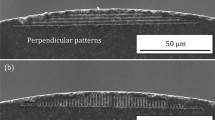Abstract
In ultra-precision diamond turning, work pieces with a surface roughness of R a < 5 nm and a form accuracy of <250 nm can be machined. Materials such as alumina, copper, electroless nickel and some plastics are mainly used in this process. In conventional ultra-precision diamond turning, it is not possible to machine ferrous metals such as hardened steel. A chemical reaction between carbon of the diamond and iron of the steel takes place and increases the tool wear significantly. The method of adding ultrasonic vibrations to the cutting process was developed to reduce the contact time between tool and work piece. This method leads to a significant reduction of the chemical process and thus enables the machining of ferrous materials with diamond tools. For the realization of this method, an ultrasonic tool holder was designed and a prototype of this tool holder was elaborated. Based on a longitudinal excited transducer, a longitudinal wave is transformed through a flexural sonotrode into a transversal wave. The aim of the new development was to reach a higher operating frequency of 100 kHz and minimize disadvantageous features related to weight and geometry of such devices.
Similar content being viewed by others
References
Grazeviciute J, Skiedraite I, Ostasevicius V, Jurenas V, Bubulis A (2006) Ultrasound application in turning process. Proc Int Conf Vibroeng 2006 152-154
Ostasevicius V, Gaidys R, Dauksevicius R, Mikuckyte S (2013) Study of vibration milling for improving surface finish of difficult-to-cut materials. Stroj Vestn-J Mech E 59(6):351–357
Moriwaki T, Shamoto E (1991) Ultraprecision diamond turning of stainless steel by applying ultrasonic vibration. Ann CIRP 40(1):559–562
Klocke F, Dambon O, Bulla B, Heselhaus M (2008) Ultrasonic assisted turning of hardened steel with mono-crystalline diamond. Proc Ann Meet Am Soc Precis Eng 2008: 165–169
Klocke F, Dambon O, Bulla B (2011) Tooling system for diamond turning of hardened steel moulds with aspheric or no rotational symmetrical geometries. Euspen Conf. Proc.
Zhang J, Suzuki N, Wang Y, Shamoto E (2014) Fundamental investigation of ultra-precision ductile machining of tungsten carbide by applying elliptical vibration cutting with single crystal diamond. Int J Mater Process Technol 214(11):2644–2659
Kim GD, Loh BG (2007) An ultrasonic elliptical vibration cutting device for micro V-groove machining: kinematical analysis and micro V-groove machining characteristics. Int J Mater Proc Technol 190:181–188
Lee J, Lee D, Jung Y, Chung W (2002) A study on micro-grooving characteristics of planar light wave circuit and glass using ultrasonic vibration cutting. J Mater Proc Technol 130–131:396–400
Goel S, Luo X, Comley P, Reuben RL, Cox A (2013) Brittle–ductile transition during diamond turning of single crystal silicon carbide. Int J Mach Tools Manuf 65:15–21
Ravindra D, John Patten J (2011) Ductile regime single point diamond turning of quartz resulting in an improved and damage free surface. Mach Sc and Tech 15:357–375
Jasinevicius RG, Duduch JG, Montanari L, Pizani PS (2012) Dependence of brittle-to-ductile transition on crystallographic direction in diamond turning of single-crystal silicon. Proc Inst Mec Eng Part B: J Eng Manuf 226:445–458
Yan J, Zhang Z, Kuriyagawa T (2009) Mechanism for material removal in diamond turning of reaction-bonded silicon carbide. IntJ Mach Tools Manuf 49(5):366–374
Wang M, Wang W, Lu Z (2012) Anisotropy of machined surfaces involved in the ultra-precision turning of single-crystal silicon—a simulation and experimental study. Int J Adv Manuf Techn 60(5–8):473–485
Tanaka H, Shimada S, Ikawa N (2004) Brittle-ductile transition in monocrystalline silicon analysed by molecular dynamics simulation. Proc Inst Mech Eng Part C J Mech Eng Sc 218(6):583–590
Goel S, Rashid WB, Luo X, Agrawal A, Jain VK (2014) A theoretical assessment of surface defect machining and hot machining of nano crystalline silicon carbide. J Manuf Sci Eng 136(2):12
Arif M, Xinquan Z, Rahman M, Kumar S (2013) A predictive model of the critical undeformed chip thickness for ductile–brittle transition in nano-machining of brittle materials. Int J Mach Tools Manuf 64:114–122
Patten JA, Jacob J (2008) Comparison between numerical simulations and experiments for single-point diamond turning of single-crystal silicon carbide. J Manuf Proc 10:28–33
Levitas VI, Ma Y, Selvi E, Wu J, Patten JA (2012) High-density amorphous phase of silicon carbide obtained under large plastic shear and high pressure. Amer Phys Soc Phys Rev B 85:054114
Szlufarska I, Ramesh KT, Warner DH (2013) Simulating mechanical behaviour of ceramics under extreme conditions. Ann Rev Mater Res 43:131–156
Zhou M, Wang XJ, Ngoi BKA, Gan JGK (2002) Brittle–ductile transition in the diamond cutting of glasses with the aid of ultrasonic vibration. J Mater Process Technol 121(2–3):243–251
Ikeda T (1990) Fundamentals of piezoelectricity. Oxford University Press, Oxford, New York, Tokyo
Lerch R (1988) Simulation of piezoelectric devices by two and three dimensional finite elements. IEEE Trans Ultrason Ferroelectr Freq Control 37:643–654
Ravindra V, Ramakrishna R (2015) Vibration analysis of tapered beam. Int J Emerg Eng Res Technol 3(5):26–32
Author information
Authors and Affiliations
Corresponding author
Rights and permissions
About this article
Cite this article
Gaidys, R., Dambon, O., Ostasevicius, V. et al. Ultrasonic tooling system design and development for single point diamond turning (SPDT) of ferrous metals. Int J Adv Manuf Technol 93, 2841–2854 (2017). https://doi.org/10.1007/s00170-017-0657-7
Received:
Accepted:
Published:
Issue Date:
DOI: https://doi.org/10.1007/s00170-017-0657-7



